Welcome to our South Indian Food Fiesta – a celebration of vibrant flavors, rich traditions, and culinary excellence.
Immerse yourself in the essence of South Indian Food cuisine, where every dish tells a story of tradition and taste.
Join us on this flavorful journey and savour the best of South Indian Food on your plate. South Indian cuisine is a rich tapestry of flavours, aromas, and culinary traditions that have evolved over centuries.
The southern states of India – Kerala, Karnataka, Tamil Nadu, Andhra Pradesh, and Telangana – each contribute unique dishes and culinary practices to create a diverse and delectable array of South Indian food.
In this journey, we will explore the regional varieties of South Indian food, from Kerala’s spice-laden dishes to Karnataka’s flavorful offerings.
1. Introduction to South Indian Cuisine
However, South Indian Food cuisine is known for its amazing and diverse culinary landscape, characterized by rice, coconut, tamarind, and various spices.
While, the cuisine is largely vegetarian, with an emphasis on rice-based dishes accompanied by an assortment of chutneys, pickles, and sambars.
Moreover, each state within the region has its unique take on South Indian cuisine, influenced by local ingredients, geography, and cultural practices.
1. The Essence of South Indian Food
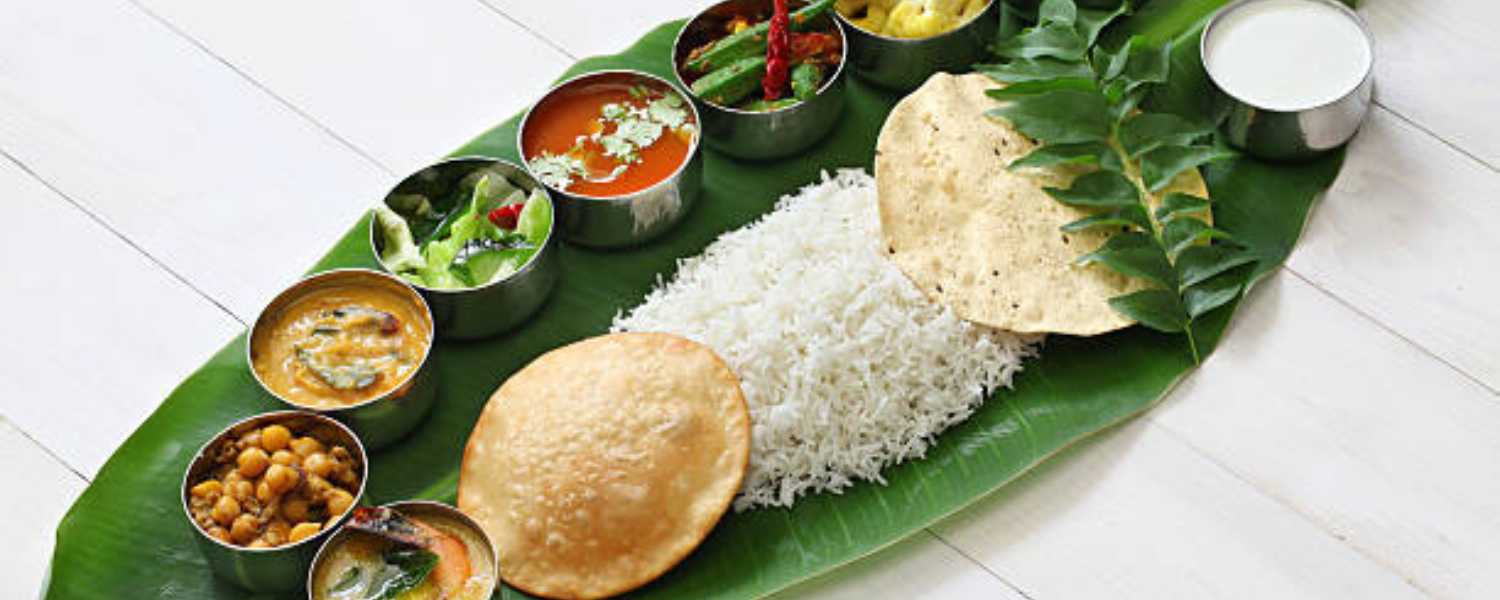
At the heart of South Indian Food cuisine lies a harmonious blend of flavours, where the use of rice, coconut, tamarind, and an array of spices takes centre stage.
While it’s a cuisine that enthusiastically embraces vegetarianism yet continues showcasing the richness of coastal seafood or the juiciness of meat in certain regions.
2. Rice, the Culinary Canvas

While Rice is more than just a staple in South Indian Food cuisine; it is the canvas on which many culinary masterpieces are painted.
Whether it’s the soft and fluffy idlis of Tamil Nadu or the fragrant biryanis of Hyderabad, rice takes on various forms, each dish telling a story of regional heritage.
3. Coconut, the Flavorful Muse

Coconut, in its many forms – grated, as milk, or in the form of oil – is the secret behind the creamy textures and distinctive flavours of South Indian dishes.
From Kerala’s coconut-infused gravies to Karnataka’s coconut chutneys, it adds a touch of richness that defines the region’s culinary identity.
4. Spices, the Soul of South Indian Cuisine
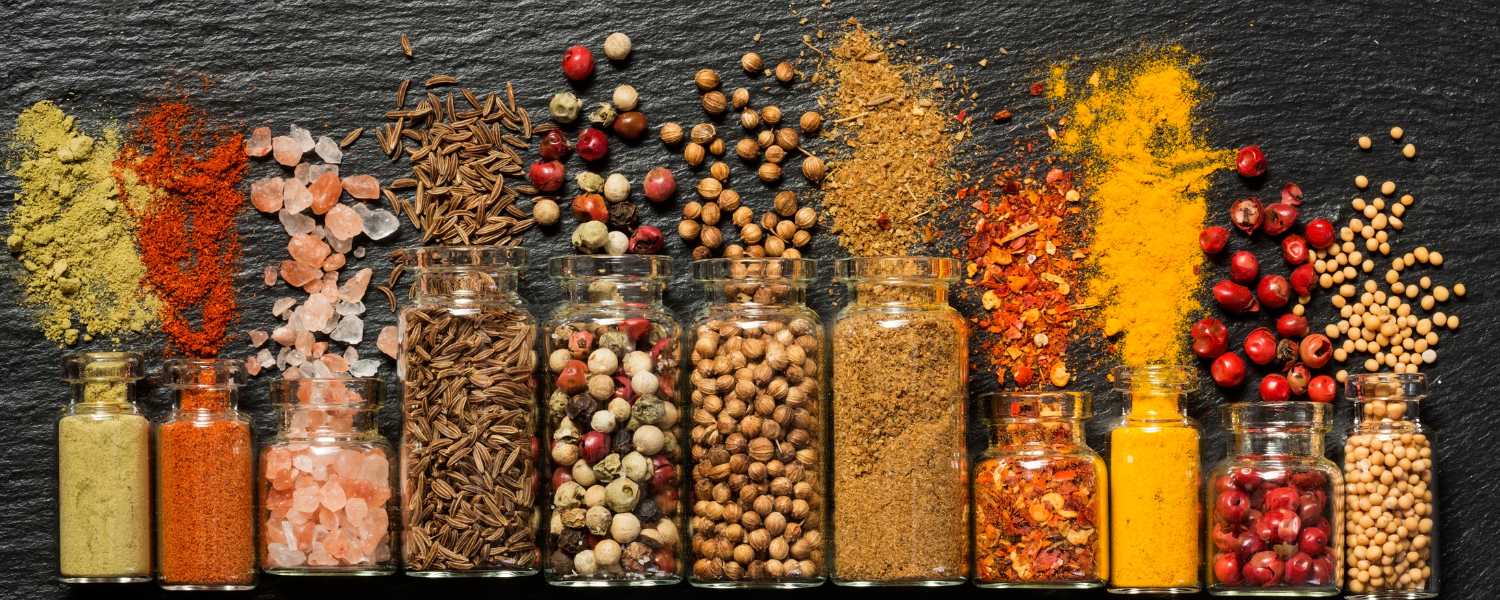
Spices are the soul of South Indian food, creating a dance of aromas and tastes that awaken the senses. The region’s love affair with spices like mustard seeds, curry leaves, black pepper, and tamarind is evident in every bite.
Although, each state adds its unique spice blend to curries, chutneys, and rice dishes, resulting in a diverse and vibrant flavour palette.
5. Diversity of Culinary Practices
While South Indian Food cuisine shares common threads, each state brings unique culinary practices.
Furthermore, the elaborate Sadhyas of Kerala, featuring an array of vegetarian dishes served on banana leaves during festivals, to the spicy biryanis of Hyderabad, South Indian food transcends boundaries.
After, It invites diners on a journey through a rich and varied gastronomic landscape.
6. Culinary Traditions Passed Down Through Generations
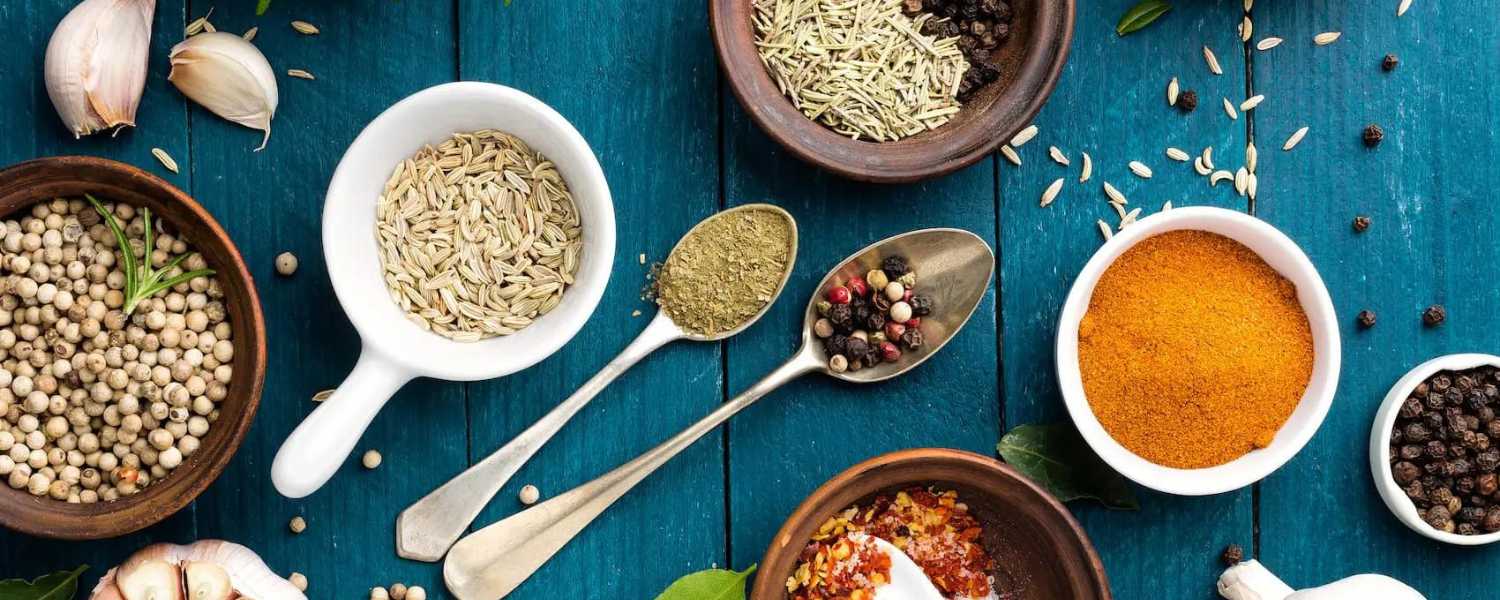
The culinary traditions of South Indian Food are not merely recipes; they are stories passed down through generations.
Whether it’s the art of making perfect dosas in Udupi or the mastery of Chettinad spices in Tamil Nadu, the techniques and secrets are handed down from mothers to daughters, chefs to apprentices, creating a legacy that continues to evolve.
7. Vegetarian Embrace
South Indian cuisine has embraced vegetarianism with open arms, offering an extensive array of plant-based delights.
Further, from the crispy vadas of Karnataka to the tangy tamarind rice of Andhra Pradesh, the vegetarian fare is not just a dietary choice but a flavorful celebration.
While, in the vast and varied landscape of South Indian cuisine, each dish is a story, each flavour a chapter, and each meal a journey through time and tradition.
However, it’s a cuisine that adapts to modern tastes while holding steadfast to its roots, offering a delightful blend of authenticity and innovation.
So, as we embark on this culinary odyssey through the southern states of India, let the flavours of South Indian food be our guide, inviting us to savour the richness, diversity, and cultural vibrancy that define this gastronomic tapestry.
2. Kerala: The Land of Spices

Kerala, often called the “Land of Spices,” is celebrated for its robust and flavorful dishes that perfectly blend coconut, spices, and seafood.
Transitioning into the exploration of Kerala’s culinary repertoire, the state boasts an array of signature dishes that reflect the region’s coastal bounty and love for spices.
Further, One such delight is the “Appam with Ishtu,” featuring soft and lacy rice pancakes served with a fragrant and mildly spiced stew of vegetables or meat.
Continuing the culinary journey, the “Karimeen Pollichathu” is another gem, presenting site fish marinated in spices, covered in banana leaves, and perfectly grilled.
Additionally, the grand “Sadhya,” a traditional feast served on a banana leaf, showcases an array of vegetarian dishes like avial, olan, and curry.
Delving deeper into the region’s influences, Kerala’s backwaters and spice plantations are crucial in shaping the culinary landscape.
While, the cultivation of spices like cardamom, black pepper, and cloves contributes to the region’s moniker as the “Land of Spices.”
Moreover, the backwaters provide a wealth of fresh fish and seafood, influencing the coastal cuisine.
Transitioning into the historical context, Kerala’s culinary traditions are deeply rooted in the historical spice trade, and the state’s markets remain vibrant hubs for spices, attracting visitors with their aromatic allure.
In conclusion, Kerala’s culinary heritage is not just about the flavours; it reflects the region’s soul and history.
1. Signature Dishes
Appam with Ishtu: Soft and lacy rice pancakes served with a fragrant and mildly spiced stew featuring vegetables or meat.
Karimeen Pollichathu: Pearl spot fish marinated in a blend of spices, wrapped in banana leaves, and grilled to perfection.
Sadhya: A feast served on a banana leaf featuring vegetarian dishes like avial, olan, and curry.
2. Flavours of Kerala
Kerala cuisine is characterized by the generous use of coconut in various forms – grated, coconut milk, and coconut oil.
Black pepper, cardamom, cinnamon, and cloves add depth and warmth to Kerala’s culinary offerings.
Seafood, including fish, prawns, and crabs, plays a significant role in Kerala’s coastal cuisine.
3. Local Influences
The backwaters of Kerala contribute to the availability of fresh seafood, influencing the coastal cuisine.
Cultivating spices, including cardamom and black pepper, has led to their extensive use in Kerala’s dishes.
3. Karnataka: A Melange of Flavors
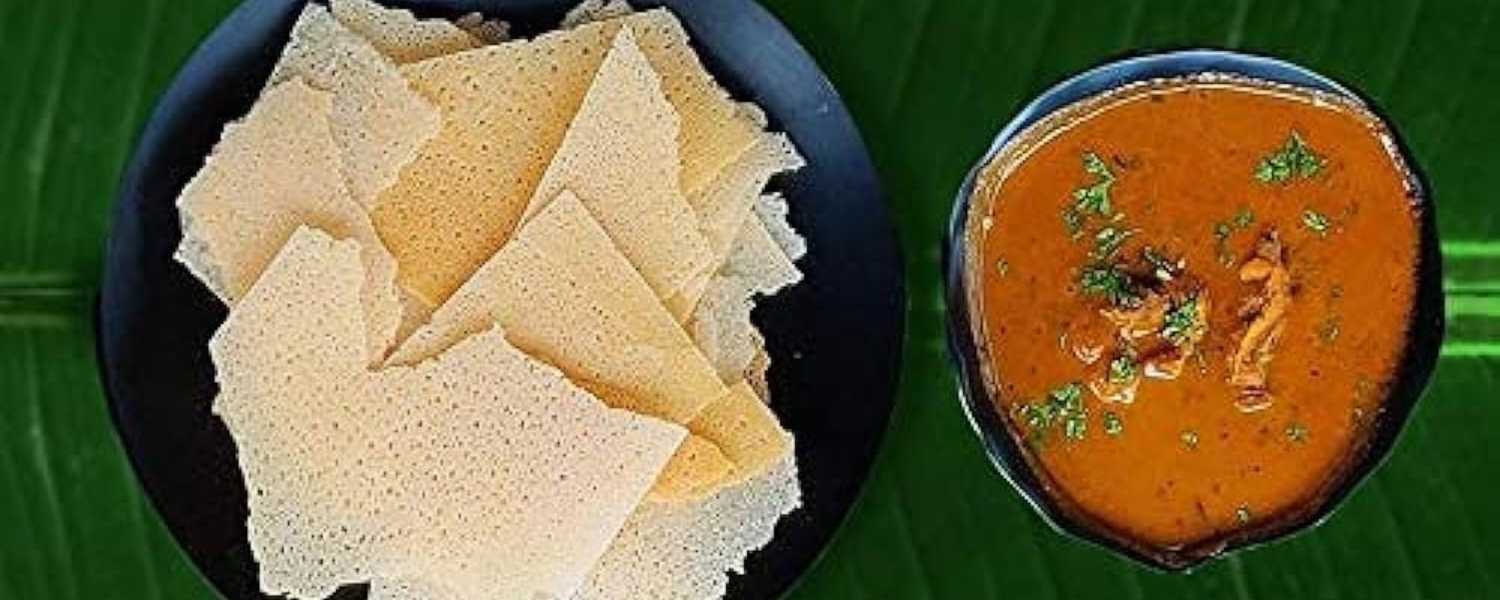
Karnataka’s cuisine is a delightful melange of flavours, incorporating the use of rice, lentils, and a variety of spices.
Transitioning into the exploration of Karnataka, a state in southern India, stands as a diverse and vibrant tapestry of flavours, offering a melange of culinary experiences that range from the spiced richness of Mysuru to the coastal delights of Mangalore.
Moreover, the state’s cuisine reflects its diverse topography, featuring a blend of aromatic spices, rice-based dishes, and a rich cultural heritage.
Furthermore, Karnataka’s culinary journey is a testament to its commitment to traditional ingredients, spices, and harmonious integration of flavours.
While, coastal Karnataka, with its proximity to the Arabian Sea, features a seafood-centric cuisine. Notable examples include “Mangalorean Fish Curry” and “Kori Rotti,” prime illustrations of the region’s love for coastal delights.
Moreover, On the other hand, the Deccan Plateau introduces unique bread varieties like “ragi rotti” and “akki rotti.” Beyond the gastronomic experience, Karnataka’s culinary heritage is intertwined with its rich history and cultural practices, making it a culinary destination that caters to diverse palates.
In conclusion, Karnataka’s culinary landscape reflects a commitment to authenticity and tradition.
From the royal indulgence of Mysuru to the coastal extravaganza of Mangalore, the state’s diverse flavours invite all to embark on a gastronomic journey that celebrates the richness of its culture and the uniqueness of its culinary traditions.
1. Signature Dishes
Bisi Bele Bath: It’s a spicy, flavorful one-pot rice dish made with lentils, vegetables, and a special spice blend.
Mysore Pak: A sweet delicacy made from besan (gram flour), ghee, and sugar, renowned for its melt-in-the-mouth texture.
Neer Dosa: Thin, delicate rice crepes that are light and served with coconut chutney.
2. Flavours of Karnataka
Karnataka cuisine is marked by jaggery, tamarind, and coconut, creating a perfect balance of sweet, tangy, and savoury flavours.
The diverse topography of Karnataka, ranging from the coastal regions to the Deccan Plateau, influences the variety of its culinary offerings.
The emphasis on ragi (finger millet) and (sorghum) showcases Karnataka’s commitment to traditional and wholesome grains.
3. Local Influences
Coastal Karnataka features a seafood-centric cuisine, with dishes like Mangalorean fish curry and prawn ghee roast.
The Deccan Plateau’s culinary traditions include unique bread varieties like ragi rotti and akki rotti.
4. Tamil Nadu: A Symphony of Spices

With its rich cultural heritage, Tamil Nadu boasts a cuisine that is a symphony of spices characterized by aromatic rice dishes, tangy tamarind-based gravies, and a plethora of chutneys.
While Mirroring the cultural richness of Tamil Nadu in its culinary practices, the traditional “Sadhya” in Tamil Nadu, akin to the Kerala Sadhya, features a grand spread of rice-based dishes served during festivals.
This culinary extravaganza includes a diverse array of flavours, textures, and aromas, creating a sensory feast that is deeply rooted in the region’s cultural fabric.
Furthermore, the meticulous preparation of each meal reflects the passion and pride of the people, preserving age-old recipes while embracing new culinary trends.
Transitioning to the city of Madurai, known for its vibrant street food scene, offers the famous “Jigarthanda,” a cooling drink made with milk, almond gum, and sarsaparilla syrup.
As one ventures into the bustling streets, they come alive with the enticing aroma of various snacks and delicacies, inviting locals and tourists alike to indulge in the city’s flavorful street food offerings.
While Expanding on Tamil Nadu’s culinary journey, it is deeply rooted in cultural practices, with each dish telling a story of tradition and innovation.
Further, From the humble idli and dosa to the elaborate Chettinad curries, Tamil Nadu’s diverse cuisine showcases the adaptability and creativity of its culinary artisans.
In conclusion, Tamil Nadu’s culinary landscape is not just a collection of dishes; it’s a vibrant narrative of cultural heritage, a tale told through the intricate blend of spices, techniques, and stories passed down through generations.
1. Signature Dishes
Chettinad Chicken Curry: A spicy and aromatic chicken curry from the Chettinad region, known for using bold spices.
Idli Sambar: Soft steamed rice cakes with a flavorful lentil-based vegetable stew.
Pongal: A comforting dish with rice and lentils seasoned with black pepper, cumin, and ghee.
2. Flavours of Tamil Nadu
Tamil Nadu’s cuisine is marked by tamarind, curry leaves, mustard seeds, and asafoetida, creating bold and distinctive flavours.
The Chettinad region is known for its fiery and aromatic dishes, featuring spices like star anise, black stone flower, and kalpasi (black stone flower).
Coconut is used extensively, especially in coastal regions, contributing to the creamy textures of dishes.
3. Local Influences
The traditional “Sadhya” in Tamil Nadu features a grand spread of rice-based dishes, similar to the Kerala Sadhya.
Madurai is renowned for its street food, including the famous Jigarthanda, a cooling drink made with milk, almond gum, and sarsaparilla syrup.
5. Andhra Pradesh and Telangana: A Spicy Affair
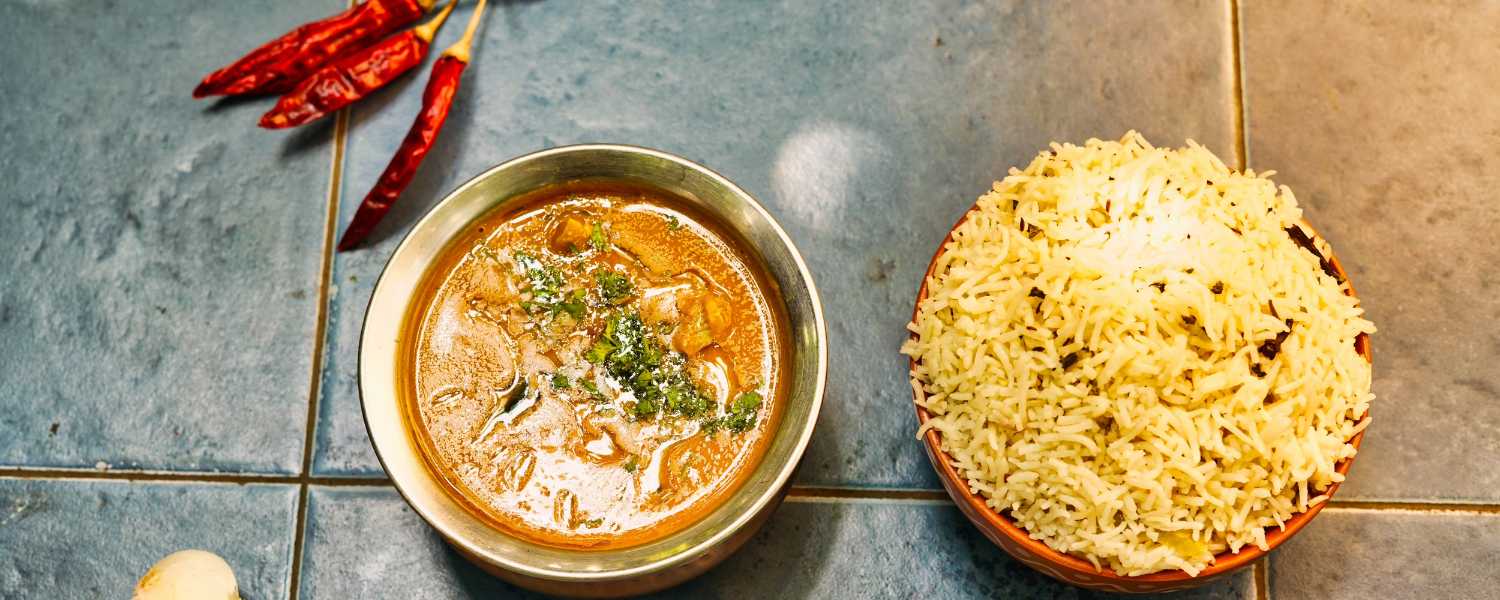
Andhra Pradesh and Telangana offer a cuisine known for its fiery and spicy flavours, emphasizing rice, tamarind, and chilli peppers.
Delving into the culinary landscape of Andhra Pradesh and Telangana reveals a vibrant tapestry of flavours, where signature dishes showcase their love for spice.
To illustrate, the iconic “Hyderabadi Biryani” stands out as a fragrant dish with basmati rice, succulent meat, and a medley of aromatic spices that tantalize the taste buds.
Adding to the fiery symphony, “Gongura Pachadi” is a tangy chutney made with leaves, tamarind, and green chillies, imparting a piquant punch to any meal.
Meanwhile, “Andhra Chicken Curry” emerges as a spicy delight featuring a rich blend of spices, curry leaves, and mustard seeds, offering a burst of bold flavours with each bite.
Transitioning to the broader culinary legacy of Andhra Pradesh and Telangana, it becomes an irresistible invitation to spice enthusiasts and lovers of bold flavours.
However, moving through the diverse menu, from the iconic biryani to the fiery chicken curries, the cuisine serves as a testament to the dynamic cultural amalgamation of this region’s gastronomic identity.
The spice-laden dishes evoke a sense of culinary adventure, beckoning those who appreciate the robust and intense flavours that define this part of India.
In conclusion, the gastronomic offerings of Andhra Pradesh and Telangana not only ignite the palate but also weave a narrative of culinary passion, regional pride, and a love for the bold and spicy in every bite.
1. Signature Dishes
Hyderabadi Biryani: A fragrant and flavorful rice dish made with basmati rice, meat (usually chicken or mutton), and aromatic spices.
Gongura Pachadi: It’s A tangy chutney made with leaves, tamarind, and green chillies.
Andhra Chicken Curry: A spicy chicken curry featuring a rich blend of spices, curry leaves, and mustard seeds.
2. Flavours of Andhra Pradesh and Telangana
The cuisine is known for its generous use of red and green chillies, creating dishes with intense and bold spice levels.
Tamarind is a key ingredient, contributing to the tangy and flavorful gravies accompanying rice-based dishes.
The iconic Andhra pickles, made with various vegetables and spices, showcase the region’s love for bold and piquant flavours.
3. Local Influences
The Nawabi influence is evident in the royal dishes of Hyderabad, including kebabs, haleem, and the decadent Qubani ka Meetha dessert.
Telangana’s cuisine features millet-based dishes, highlighting the region’s agricultural practices.
6. Pondicherry: French Flair in South India
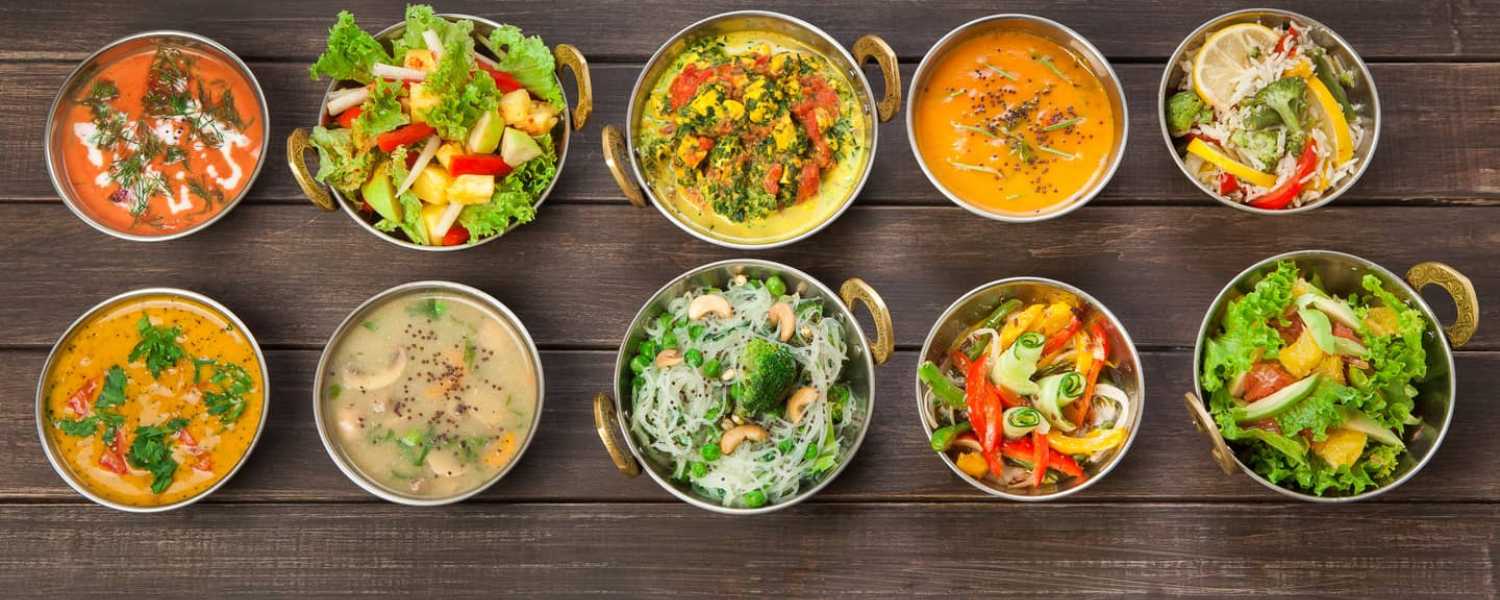
Pondicherry, with its unique blend of French and Indian cultures, offers a distinct culinary experience. However, the cuisine here is a harmonious fusion, seamlessly combining French influences with traditional South Indian flavours.
Delving into Pondicherry’s culinary scene reveals a vibrant tapestry adorned with signature dishes that showcase its French-inspired flair.
The “Meen Varuval” is a spicy and tangy fish fry, an embodiment of Pondicherry’s coastal influence and a testament to the skillful fusion of French culinary techniques with local South Indian ingredients.
While, adding to the gastronomic mosaic, “Pondicherry Pasta” emerges as a French-inspired pasta dish with a South Indian twist.
Further, this delightful creation often features local spices and herbs, creating a symphony of flavours that transcends cultural boundaries.
Meanwhile, “Kuzhi Paniyaram” represents small, round rice and lentil dumplings, a popular breakfast item that embodies the convergence of French and Tamil culinary influences.
Pondicherry’s culinary allure extends beyond individual dishes, serving as a testament to its cultural diversity and historical influences.
The union of French finesse with South Indian flavours not only creates a culinary landscape that is both sophisticated and comforting but also reflects the rich tapestry of Pondicherry’s heritage.
In essence, the delightful fusion of cultures in Pondicherry’s gastronomic journey showcases a unique blend of history, diversity, and culinary creativity.
It stands as a must-visit destination for those seeking a delightful and immersive experience that goes beyond the plate, inviting visitors to savour the essence of cultural convergence in every bite.
1. Signature Dishes
Meen Varuval: A spicy and tangy fish fry that showcases Pondicherry’s coastal influence.
Pondicherry Pasta: A French-inspired pasta dish with a South Indian twist, often featuring local spices and herbs.
Kuzhi Paniyaram: Small, round rice and lentil dumplings, a popular breakfast item with French and Tamil influences.
2. Flavours of Pondicherry
French pastries, croissants, and baguettes coexist with traditional South Indian dosas and idlis, creating a delightful fusion.
Local seafood, such as squid and prawns, takes centre stage in many Pondicherry dishes, reflecting the coastal setting.
Using tamarind, mustard seeds, and curry leaves adds a traditional South Indian touch to the French-inspired cuisine.
3. Local Influences
The French Quarter of Pondicherry, with its charming cafes and bakeries, offers a taste of European-style pastries and desserts.
The Ashram Canteen serves simple, vegetarian meals influenced by the philosophy of Sri Aurobindo, attracting visitors seeking a tranquil dining experience.
7. Kerala’s Malabar Region: Spice Routes and Culinary Delights

1. Signature Dishes
Malabar Biryani: A fragrant and flavorful biryani made with aromatic basmati rice, spices, and succulent meat, often garnished with fried onions and raisins.
Pathiri: Soft, thin rice pancakes that pair well with vegetarian and non-vegetarian curries.
Erachi Varutharacha Curry: A rich and spicy meat curry made with coconut and a mix of Malabar spices.
2. Flavours of Malabar
Malabar cuisine is represented by spices like black pepper, cardamom, and cinnamon, reflecting the region’s historical spice trade.
Coconut is a staple ingredient, and its various forms, including grated coconut, coconut milk, and coconut oil, play a crucial role in Malabar dishes.
The cuisine’s rich and hearty flavours are often complemented by the tanginess of tamarind and the subtle sweetness of jaggery.
3. Local Influences
Malabar’s historic connection to the spice trade has left a lasting impact on its cuisine, making it a haven for spice enthusiasts.
The bustling markets of Malabar, such as those in Kozhikode and Kannur, offer a sensory experience with their aromatic spices, fresh produce, and local specialties.
8. Chettinad, Tamil Nadu: A Gastronomic Heritage

Chettinad, a region in Tamil Nadu, proudly boasts a distinctive culinary heritage known for its aromatic spices, unique dishes, and complex flavours.
Consequently, Chettinad cuisine, characterized by its rich tapestry of flavours, stands as a testament to the opulence and culinary finesse of the Chettiar community.
Further, upon delving into the culinary offerings of Chettinad, one unveils gems like the “Chettinad Chicken Curry,” a fiery and aromatic masterpiece crafted with a blend of Chettinad spices, curry leaves, and tamarind.
Furthermore, this culinary delight not only tingles the taste buds but also exemplifies the intricate spice composition that defines Chettinad cuisine.
Equally enticing is the “Chettinad Fish Fry,” where fish is marinated in a flavorful mix of spices, including fennel, cumin, and coriander, before being shallow-fried to perfection.
The result is a dish that captures the essence of Chettinad’s culinary artistry and its penchant for bold and harmonious flavours.
Venturing further into Chettinad’s gastronomic landscape, one encounters “Atho,” a popular street food featuring flat rice noodles tossed with a spicy and tangy sauce, garnished with various toppings.
This dish not only showcases the region’s culinary diversity but also reflects its vibrant street food culture.
Moreover, the cuisine, enriched by a variety of meats such as chicken, mutton, and fish, is prepared with Chettinad’s signature spice blend.
However, each dish becomes a canvas where the unique blend of spices paints a portrait of tradition, creating a sensory experience that transcends mere sustenance.
Chettinad’s penchant for culinary artistry extends to its desserts, with sweets like athirasam and paal paniyaram showcasing the region’s love for delectable and intricately crafted treats.
In conclusion, with its gastronomic heritage, Chettinad emerges as a culinary destination that beckons those searching for complex flavours, aromatic spices, and a rich cultural tapestry.
Each dish, steeped in tradition and luxury, invites all to savour the distinctive tastes of Chettinad, offering a sensory journey through the heart of this flavorful region.
1. Signature Dishes
Chettinad Chicken Curry: A fiery and aromatic chicken curry made with Chettinad, curry leaves, and tamarind.
Chettinad Fish Fry: Fish marinated in a flavorful mix of spices, including fennel, cumin, and coriander, and then shallow-fried to perfection.
Atho: A popular street food featuring flat rice noodles tossed with a spicy and tangy sauce, garnished with various toppings.
2. Flavours of Chettinad
Chettinad cuisine is renowned for using spices like star anise, stone flower, and maratti mokku (dried flower pods), creating a unique and complex flavour profile.
The cuisine features a variety of meats, including chicken, mutton, and fish, prepared with Chettinad’s signature spice blend.
Chettinad sweets, such as athirasam and paal, showcase the region’s love for delectable desserts.
3. Local Influences
The mansions of Chettinad, known as “Chettinad houses,” are architectural marvels that reflect the opulence and grandeur of the Chettiar community.
9 . Udupi, Karnataka: Temple Town Delicacies
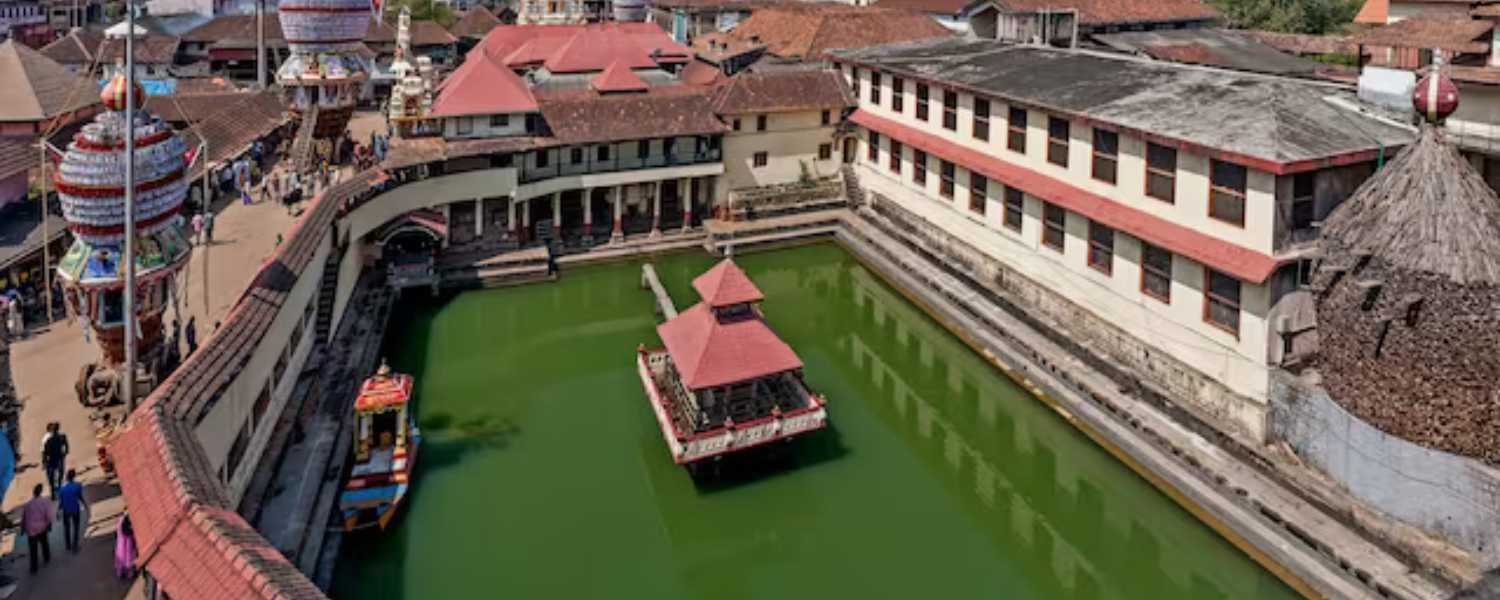
Udupi, a town in Karnataka, is renowned for its simple yet flavorful vegetarian cuisine. Ingrained with the culinary traditions of the Udupi Krishna Temple, the town’s food is a delightful blend of tradition and devotion.
Furthermore, Udupi’s culinary repertoire is adorned with signature dishes that showcase its unwavering commitment to vegetarian delights.
Further, “Masala Dosa,” a ubiquitous dish, features thin rice crepes filled with a spiced potato mixture, served with coconut chutney, and tangy sambar.
In addition, “Udupi Sambar” is a unique sambar preparation featuring a variety of vegetables, lentils, and a special spice blend.
Udupi’s close association with the Krishna Temple has not only enriched the local cuisine but also led to the global popularity of Udupi dishes like masala dosa and idli in international vegetarian cuisine.
Moreover, the town’s numerous vegetarian restaurants, often referred to as “Udupi restaurants,” serve authentic Udupi cuisine, providing a taste of traditional South Indian flavours.
The town’s unwavering devotion to culinary traditions and simplicity creates a dining experience that transcends the mundane, inviting all to savour the spiritual essence of Udupi’s temple town delicacies.
1. Signature Dishes
Masala Dosa: Thin rice crepes filled with a potato mix, served with coconut chutney and sambar.
Udupi Sambar: A unique sambar preparation featuring a variety of vegetables, lentils, and a special spice blend.
Rasam: A tangy and aromatic soup made with tamarind, tomatoes, and a blend of spices, often served as a comforting accompaniment.
2. Flavours of Udupi
Udupi cuisine uses locally available ingredients, including rice, coconut, and fresh vegetables.
Using coconut in different forms, such as grated coconut and coconut oil, contributes to the richness and distinctiveness of Udupi dishes.
3. Local Influences
Udupi’s association with the Krishna Temple has led to the spread of Udupi cuisine to various parts of the world, making dishes like masala dosa and idli popular in international vegetarian cuisine.
While, the town’s numerous vegetarian restaurants, often called “Udupi restaurants,” serve authentic Udupi cuisine, providing a taste of traditional South Indian flavours.
10. Mangalore, Karnataka: Coastal Delights and Seafood Extravaganza

The Mangalore, a coastal city in Karnataka, is celebrated for its rich seafood offerings and culinary heritage inspired by its closeness to the Arabian Sea.
In contrast, Mangalore, nestled along the southwestern coast of Karnataka, is a coastal paradise that beckons with its culinary treasures and seafood extravagance.
Moreover, the cuisine of Mangalore is a celebration of coastal flavours, vibrant spices, and a rich culinary heritage shaped by its proximity to the Arabian Sea.
From aromatic fish curries to crispy dosas, Mangalore offers gastronomic travel that captures the essence of coastal Karnataka.
Furthermore, the region’s coastal setting contributes to the availability of fresh seafood, influencing Mangalore’s cuisine with various fish, prawns, and crabs.
Additionally, the vibrant fish markets of Mangalore, such as the bustling Hampankatta Fish Market, offer a sensory experience with their array of fresh catch and lively atmosphere.
Moreover, the city’s diverse culinary influences, including Tulu, Konkani, and Beary cuisines, contribute to the richness and diversity of Mangalorean food.
In conclusion, Mangalore, with its coastal delights and seafood extravaganza, emerges as a culinary destination that invites all to savour the flavours of the sea and experience the richness of Karnataka’s coastal culinary heritage.
1. Signature Dishes
Kori Rotti: A unique dish featuring crispy rice wafers served with a spicy chicken curry, highlighting Mangalore’s diverse culinary offerings.
Neer Dosa: Thin rice crepes that are soft and delicate, often served with coconut chutney and fish curry.
2. Flavours of Mangalore
Mangalorean cuisine is marked by the liberal use of coconut, curry leaves, and tamarind, creating a harmonious balance of flavours.
The region’s coastal setting contributes to the availability of fresh seafood, influencing Mangalore’s cuisine with various fish, prawns, and crabs.
Using unique spices like Byadgi red chillies and Kundapur masala adds a distinctive flavour to Mangalorean dishes.
3. Local Influences
The vibrant fish markets of Mangalore, such as the bustling Hampankatta Fish Market, offer a sensory experience with their array of fresh catch and lively atmosphere.
Mangalore’s street food scene, with specialties like goli baje (fried dumplings) and kori roti, reflects the region’s culinary diversity and local favourites.
11. Mysuru, Karnataka: Royal Grandeur and Culinary Elegance
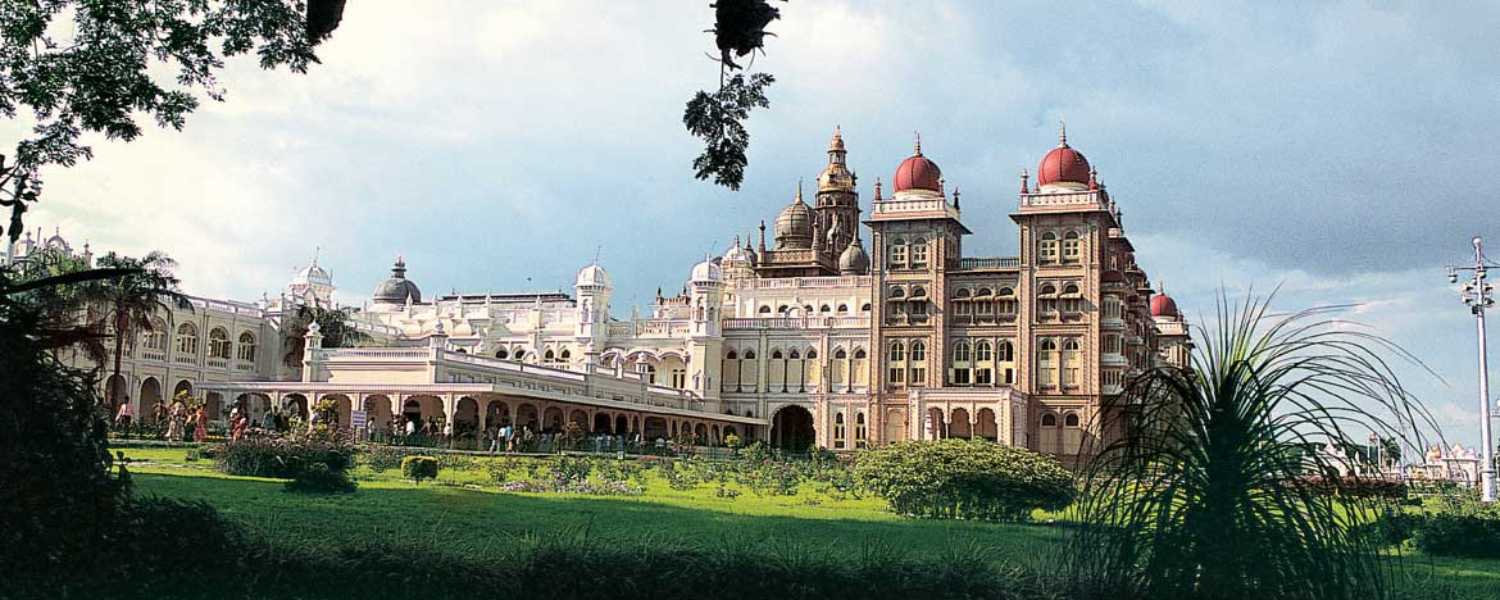
Mysuru, the cultural capital of Karnataka, is renowned for its royal history, majestic palaces, and culinary heritage that reflects the grandeur of the Wodeyar dynasty. However, the city’s cuisine is a harmonious blend of traditional Karnataka flavours with a touch of royal sophistication.
Furthermore, Mysuru’s culinary journey celebrates royal grandeur and culinary elegance, offering a regal dining experience that resonates with the city’s historic charm.
Moreover, Mysuru’s culinary repertoire boasts signature dishes that exemplify its royal grandeur and culinary finesse. For instance, “Mysore Pak” is a sweet delicacy made from besan (gram flour), ghee, and sugar, known for its melt-in-the-mouth texture and association with the Mysuru Palace.
Additionally, “Mysore Masala Dosa” is an interpretation of the classic masala dosa, featuring a spiced potato filling and a unique red chutney, creating a delightful flavour profile.
Although, “Chitranna,” a tangy and flavorful rice dish made with lemon, turmeric, and a special spice blend, is often served during festivals and occasions.
Mysuru cuisine reflects the regal influence of the Wodeyar dynasty, known for its patronage of the arts and refinement in culinary tastes.
Moreover, using aromatic spices like cinnamon, cloves, and cardamom adds a touch of elegance to Mysuru’s dishes, elevating them to a royal dining experience.
While, the Mysuru Palace, with its opulent architecture and cultural significance, is a historic landmark and an inspiration for the city’s culinary traditions.
Furthermore, the bustling Devaraja Market in Mysuru offers a vibrant array of local spices, fresh produce, and traditional ingredients, providing a glimpse into the city’s culinary diversity.
Additionally, Mysuru’s connection to sandalwood, a prized local resource, is evident in its use in culinary and aromatic applications, adding a unique touch to the city’s flavours.
In conclusion, Mysuru, with its royal grandeur and culinary elegance, invites visitors to experience a dining journey fit for royalty. From the iconic Mysore Pak to the regal Mysore Masala Dosa, the city’s culinary offerings capture the essence of Karnataka’s cultural richness and historical splendour
1. Signature Dishes
Mysore Pak: A sweet delicacy made from besan (gram flour), ghee, and sugar, known for its melt-in-the-mouth texture and association with the Mysuru Palace.
Mysore Masala Dosa: A variation of the classic masala dosa featuring a spiced potato filling and a unique red chutney, creating a delightful flavour profile.
Chitranna: A tangy and flavorful rice dish made with lemon, turmeric, and a special spice blend, often served during festivals and occasions.
2. Flavours of Mysuru
Mysuru cuisine reflects the regal influence of the Wodeyar dynasty, known for its patronage of the arts and refinement in culinary tastes.
Using aromatic spices like cinnamon, cloves, and cardamom adds a touch of elegance to Mysuru’s dishes, elevating them to a royal dining experience.
Local ingredients, including Mysuru pak sandalwood powder, contribute to the distinctiveness of the city’s culinary offerings.
3. Local Influences
Although, the Mysuru Palace, with its opulent architecture and cultural significance, is a historic landmark and an inspiration for the city’s culinary traditions.
The bustling Devaraja Market in Mysuru offers a vibrant array of local spices, fresh produce, and traditional ingredients, providing a glimpse into the city’s culinary diversity.
Conclusion:
However, South Indian food is a captivating journey that takes us through the diverse landscapes, cultural nuances, and unique flavours of Kerala, Karnataka, Tamil Nadu, Andhra Pradesh, and Telangana.
Embarking on this culinary odyssey, we savour the coastal delights of Kerala, where the marriage of coconut, tamarind, and an array of spices creates a symphony of flavours that perfectly captures the essence of coastal living.
Moreover, moving eastward, we encounter the spicy offerings of Andhra Pradesh, where fiery biryanis and spicy curries tantalize the taste buds, leaving an indelible mark on the South Indian gastronomic tapestry.
Furthermore, each state, from the lush greenery of Karnataka to the vibrant traditions of Tamil Nadu, contributes its distinct chapter to the rich gastronomic tapestry of South India.
Whether you’re relishing the coconut-infused curries of Kerala, with the richness of coconut milk imparting a creamy texture to the dishes, or indulging in the fiery biryanis of Hyderabad, South Indian food is a celebration of tradition, diversity, and a symphony of flavours that continues to captivate taste buds around the world.
Therefore, the next time you embark on a culinary adventure in South India, remember to savour the nuances of each state’s cuisine, for it’s a journey that promises a delightful and unforgettable experience.
Further, drawing the curtains on our culinary expedition, traversing the diverse landscapes from Kerala’s backwaters to Karnataka’s spice plantations, we immerse ourselves in the rich tapestry of South Indian food.
While, this gastronomic journey has been more than a mere exploration of regional cuisines; it has been an odyssey through time, tradition, and the vibrant cultural heritage that defines the southern states of India.
1. South Indian Cuisine: A Symphony of Flavors
Rice, coconut, tamarind, and an array of spices serve as musical notes, creating a melody that resonates with the diverse palates of those who embark on this gastronomic journey.
Transitioning into the regional intricacies, the use of spices varies from the fiery red chillies of Andhra Pradesh to the subtle aromas of cardamom and cloves in Mysuru, each region crafting its unique culinary composition.
2. Vegetarian Extravaganza: A South Indian Specialty
One of the hallmarks of South Indian cuisine is its embrace of vegetarianism.
Transitioning the diverse offerings, from Udupi’s crispy dosas to Kerala’s flavorful, vegetarian dishes take center stage, showcasing the region’s mastery in transforming humble ingredients into culinary delights.
Moreover, the simplicity of ingredients belies the complexity of flavours, and each dish becomes a testament to the culinary expertise passed down through generations.
3. Seafood Symphony: Coastal Influences on South Indian Palates
The coastal regions, be it the backwaters of Kerala, the shores of Mangalore, or the Bay of Bengal in Tamil Nadu, have bestowed South Indian cuisine with a treasure trove of seafood delights.
Notably, the marriage of coconut, tamarind, and an array of spices makes a symphony of flavours that catches the nature of coastal living.
Transitioning into the culinary experience, from the spicy tang of fish curries to the delicate crunch of fried calamari, South India’s coastal influence is a culinary gift that keeps giving.
4. Heritage on a Plate: Culinary Legacies of Chettinad and Mysuru
Chettinad, with its aromatic spices and complex flavours, invites us into the grandeur of its culinary heritage. The region’s dishes, rooted in tradition and finesse, reflect the luxury of the Chettiar community.
Similarly, Mysuru, with its royal grandeur, showcases a culinary elegance shaped by the Wodeyar dynasty.
Transitioning seamlessly, the city’s dishes mirror its historical past’s refinement and cultural richness, from Mysore Pak to the regal Mysore Masala Dosa.
5. Invitation to Indulge: A Culinary Kaleidoscope
Our journey through South Indian cuisine invites us to indulge and savour the myriad flavours of the culinary landscape.
To begin with, each bite is a connection to the region’s history, a nod to its cultural diversity, and an immersion into the warmth of its hospitality.
Moreover, in our exploration, we find that the regional varieties have not only tantalized our taste buds but also unveiled the stories, traditions, and hearts of South India.
Additionally, in concluding our exploration of South Indian food, we find that it’s more than just a gastronomic experience; it’s a cultural celebration on a plate.
In essence, the regional varieties have not only tantalized our taste buds but also unveiled the stories, traditions, and the heart of South India.
To sum up, until we meet again in the embrace of South Indian spices, may your culinary journeys be as vibrant and diverse as the flavours that adorn this captivating region.
You can even explore the South Indian Food here!










